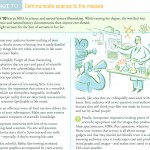Can science be crowdsourced? That is, can scientists turn to the average citizen for help in collecting data?
Earlier this week, Genomes Unzipped, a group of genetics-savvy bloggers, announced that its 12 members had made the results of their direct-to-consumer genetic tests freely available online. Members of another group, the Personal Genomes Project , have also made their genetic data available. In a sense, by making their data freely available, these groups—or crowds— have moved toward crowdsourced genomic data.
I have no doubt geneticists will be able to use these citizen-sourced datasets to better understand our human blueprint. But these genomics groups are made up of a special breed- many of them are scientists themselves and were directly involved in the development of the data-sharing plan. Can the average citizen contribute to crowdsourced science?
Sure, especially if they don’t mind getting close to some grisly scenes. The California Roadkill Observation System is crowdsourcing data from volunteers who spot roadkill on California highways. Registered volunteers enter the location, species, and condition of roadkill online. The project aims to understand the impacts of wildlife-vehicle collisions with the goal of informing future human development.
There are also less gruesome ways of collecting data for scientists. Project Feederwatch has volunteers count the number and kinds of bird species that visit their feeders. The data can be used to monitor changes in birds’ seasonal ranges and the abundance of birds over different years, perhaps alerting scientists to at-risk species.
In these examples, the crowds offer something unique to researchers: new genomes to analyze, statewide coverage of the highway system, and access to the backyards of private citizens.
So what information can crowds offer to the budding science journalist? A story on the Online Journalism Review describes an example of crowdsourcing that has a clear connection to science writing. The US Geological Survey has a site called “Did you Feel It?” that allows people to report ground-shaking felt at home.
Data from “Did you Feel It?” is also used by scientists. In fact, I think most crowdsourced data that would be useful to science writers could also be data for scientists. Any thoughts?







It’s interesting to hear of crowdsourced data. I can certainly think of ways for news organizations to ask their readers to report from wherever they are. Or to ask everyone to report about a specific topic or answer a particular question. And it’s not just news organizations; individual journalists with a devoted Twitter or Facebook following could do the same.
Apart from gathering data, I’ve heard of other examples of crowdsourcing where scientists harness the power of large groups of people to analyze their data. Apparently there’s things we can do that can be much harder for a computer to do.
For example, there was this report a few months back of researchers using crowdsourcing to predict how proteins would fold. Humans often did better than computers at predicting certain aspects. Of course, the researchers had to design a great game mechanic to get people involved, but it just shows it can be done.
And NASA has been using similar crowdsourcing mechanisms to analyze some of their data, or to generate information that could be used to improve their computer algorithms (Just Google search NASA and Crowdsourcing or Crowdsourced for lots of examples).
So I think there’s a lot of potential there. A neuroscience researcher I spoke to earlier this year was trying to develop better computer algorithms to map the brain. But he also said that computers could be surprisingly dumb, and that he could probably achieve quicker results if he could get 10,000 humans to analyze his data.
We know that it’s possible to access a lot more than 10,000 people on the internet or through social media, so maybe that’s something more scientists should harness.